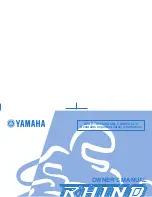
B
2
Repair and Service Manual
GENERAL INFORMATION AND ROUTINE MAINTENANCE
Read all of SAFETY and this section before attempting any procedure. Pay particular attention to Notices, Cautions, Warnings and Dangers.
653045
SERVICING THE VEHICLE
To decrease the risk of severe
injury or death, resulting from
improper servicing techniques,
observe the following Warnings:
Do not attempt any type of servicing operations
before reading and understanding all notices, cau-
tions and warnings in this manual.
The drive wheels must be lifted and supported on
jack stands before you do any service to the power-
train when the engine is in operation.
Wear eye protection when you ser-
vice the vehicle. Be careful when
you do work around battery, use sol-
vents or compressed air.
To decrease the risk of electrical arc,
which can cause a battery explosion, disable all
electrical loads from the battery before you remove
the battery wires.
To decrease the risk of engine damage, do not oper-
ate the vehicle at full throttle for more than 5 sec-
onds with the drive wheels lifted off the ground.
The vehicle owner and service technician must carefully
follow the procedures recommended in this manual. The
preventative maintenance, applied at recommended
intervals, keeps the vehicle dependable and decreases
the costs for the repairs.
In any product, components will eventually fail to perform
properly as the result of normal use, age, wear or abuse.
It is virtually impossible to anticipate all possible compo-
nent failures or the manner in which each component
may fail.
A vehicle requiring repair indicates the vehicle is no lon-
ger functioning as designed and should be considered
potentially hazardous. Use extreme care when working
on a vehicle. When diagnosing, removing or replacing
any components that are not operating properly, consider
the safety of yourself and those around you, should the
component move unexpectedly.
Some components are heavy, spring loaded, highly corro-
sive, explosive, may produce amperage or reach high
temperatures. Gasoline, carbon monoxide, battery acid
and hydrogen gas could result in serious bodily injury to
the technician/mechanic and bystanders, if not treated
with the utmost caution. Be careful not to place hands,
face, feet or body in a location that could expose them to
injury should an unforeseen dangerous situation occur.
Always use the appropriate tools listed in the tool list and
wear approved safety equipment.
Before a new vehicle is put into operation, do the items
shown in the INITIAL SERVICE CHART.
Fig. 2 Initial Service Chart
FUEL
To decrease the risk
of severe
injury or death from improper fuel
handling:
Do not smoke near the fuel tank.
Do not add fuel near open flame or electrical items
that can cause a spark.
Always handle gasoline in a well ventilated area.
Always wear eye protection to protect against
splashed fuel and fuel vapors.
Inspect the fuel cap, tank and other components for
leaks or damage that can cause a hazardous condi-
tion.
Oxygenated or reformulated gasoline, is mixed with
alcohols or ethers. Excessive amounts of these
blends can damage the fuel system or cause perfor-
mance problems. If any operating problems occur,
use gasoline with a lower percentage of alcohol or
ether.
Use clean regular grade unleaded fuel. The Ethanol
blend fuel up to 10% is permitted.
Do not
use gasoline that contains methanol.
High altitude or heavy use/load applications can benefit
from higher octane gasoline.
FUEL TANK
The fuel tank is located below the seat on the passenger
side of the vehicle. Fill the tank with clean, automotive
grade gasoline.
High octane gasoline can increase the performance of
vehicles that are used in high altitudes, have heavy use or
heavy load applications.
Item
Service Operation
Battery
Charge battery
Seats
Remove protective plastic covering
Brakes
Check operation and adjust if necessary
Establish new vehicle braking distance
Tires
Check pressure
Fuel
Fill tank with correct fuel
Engine
Check oil level
Property of American Airlines
















































